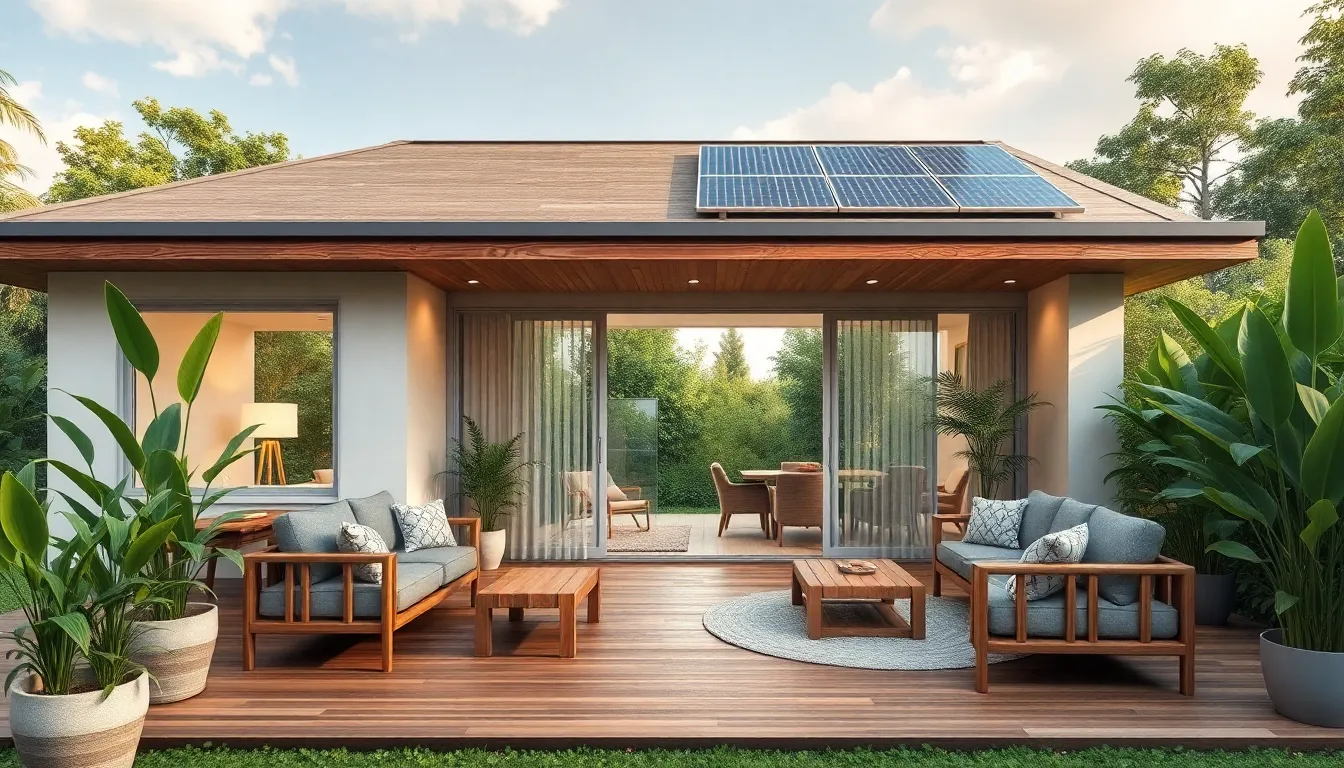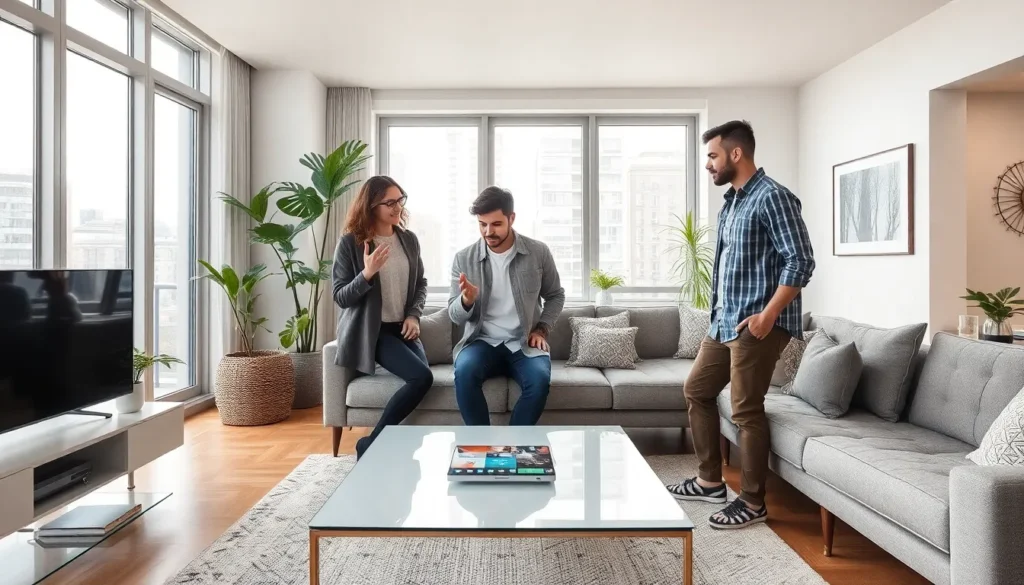Home design isn’t just about slapping on a fresh coat of paint and calling it a day. It’s a thrilling adventure where creativity meets technology, and the results can be nothing short of spectacular. Imagine turning your living room into a smart haven that anticipates your needs before you even know them. Sounds like something out of a sci-fi movie, right? Well, welcome to the future of home design!
Table of Contents
ToggleOverview of Home Design Innovations
Home design innovations incorporate advanced technologies and creative concepts to enhance functionality and aesthetics. Smart home systems enable homeowners to control lighting, temperature, and security seamlessly through smartphones or voice commands. This integration allows for a more personalized living experience that adapts to specific needs and preferences.
Sustainable design practices are gaining traction, promoting eco-friendly materials and energy-efficient appliances. Homes now incorporate solar panels and rainwater harvesting systems to minimize environmental impact. Incorporating such elements reduces utility costs while contributing to a healthier planet.
Modular design concepts are transforming interior spaces. These concepts offer flexibility and adaptability, allowing rooms to serve multiple functions. Furniture that can be easily reconfigured enhances usability and maximizes space, ideal for urban living.
Innovative space-saving solutions, like foldable furniture and built-in storage, maximize small areas without sacrificing style. Local artisans and designers are increasingly creating custom pieces that reflect individual tastes and suit specific spaces. Such personalization leads to unique environments that feel more like home.
Wellness-focused design incorporates biophilic elements, promoting mental and physical health. Natural light, plant life, and natural materials create a calming atmosphere that boosts well-being. Integrating these aspects leads to improved air quality and overall comfort.
Overall, home design innovations reflect a shift toward smarter, more sustainable, and personalized living environments. The blend of technology, creativity, and sustainability defines modern home spaces, transforming them into expertly tailored havens for their occupants.
Sustainable Design Trends

Sustainable design continues to shape home innovations, emphasizing environmental responsibility and long-term utility savings. This approach integrates various eco-friendly practices and materials aimed at minimizing ecological footprints.
Eco-Friendly Materials
Eco-friendly materials dominate modern home design, promoting sustainability without sacrificing aesthetics. Bamboo offers a renewable option for flooring and cabinetry, while reclaimed wood serves as a charming alternative for furniture and structural elements. Natural stone adds durability and beauty, often sourced locally to reduce transportation emissions. High-quality recycled materials also contribute, exemplified by insulation made from recycled denim or bottles. Selecting finishes, paints, and adhesives with low volatile organic compounds ensures healthier indoor air quality. Ultimately, leveraging these materials enhances both the environment and home appeal.
Energy Efficiency Solutions
Energy efficiency solutions play a crucial role in sustainable design. Smart thermostats optimize heating and cooling, adjusting automatically based on occupancy patterns. Energy-efficient appliances utilize advanced technology to consume less power, often qualifying for tax benefits. Solar panels harness renewable energy, significantly reducing electricity costs while supporting grid independence. Low-flow fixtures minimize water consumption in bathrooms and kitchens, promoting resource conservation. These solutions not only lower utility bills but also enhance the home’s market value, making them a smart investment for long-term sustainability.
Smart Home Technologies
Smart home technologies revolutionize how individuals interact with their living spaces. These innovations enhance comfort, security, and energy efficiency, creating a more intuitive home environment.
Home Automation Systems
Home automation systems streamline daily tasks by allowing remote control of various functions. Users can manage lighting, heating, and appliances from smartphones or voice commands. Smart thermostats adjust temperatures automatically based on occupancy patterns, resulting in energy savings. Smart lighting adapts according to natural light levels, creating an inviting atmosphere. The integration of these systems simplifies home management, enhancing convenience and efficiency for homeowners.
Security Innovations
Security innovations enhance the safety of homes through advanced technology. Integrated cameras and motion sensors monitor properties in real time. Homeowners can receive alerts and access live feeds via mobile devices. Smart locks offer keyless entry and remote locking features, ensuring enhanced access control. These security solutions provide peace of mind, allowing residents to feel secure even when away from home.
Aesthetic Trends in Home Design
Home design trends prioritize aesthetics alongside functionality. Current innovations reflect a strong focus on minimalism and nature-inspired elements, emphasizing both space efficiency and well-being.
Minimalism and Maximizing Space
Minimalism emphasizes simplicity and openness. This trend utilizes clean lines, neutral colors, and clutter-free spaces. Designers often select multifunctional furniture to maximize usability, such as sleeper sofas and extendable tables. Urban dwellings particularly benefit from these spatial solutions, allowing small units to serve multiple purposes. Creating a serene atmosphere invites relaxation while promoting mental clarity. Clutter management also contributes to minimalism, fostering environments that prioritize open space over excess.
Biophilic Design Elements
Biophilic design incorporates natural elements to enhance well-being. Integrating greenery inside homes promotes a connection to nature. Designers frequently use large windows for ample natural light, creating an inviting ambiance. Materials such as wood and stone evoke an organic feel, contributing to tranquility. Incorporating water features, like indoor fountains or aquariums, fosters a soothing environment. The inclusion of plants not only beautifies spaces but also improves indoor air quality. Prioritizing these elements supports mental health, encouraging a balanced lifestyle.
Future of Home Design Innovations
Innovations in home design continue to reflect technological advancements and consumer preferences. Smart materials respond to environmental changes, enhancing energy efficiency in homes. For instance, self-tinting windows adjust transparency based on sunlight, improving comfort while reducing the need for climate control.
Augmented reality takes shape in design processes, allowing homeowners to visualize changes before implementation. Virtual tours offer insights into layouts and furnishings, creating informed decision-making. These technologies streamline renovations, allowing occupants to tailor spaces to their unique lifestyles.
Sustainable building techniques advance with 3D printing, enabling the construction of eco-friendly homes. Materials produced with minimal waste and energy demarcate a significant shift toward responsible building. Nature-inspired designs, such as green roofs, promote biodiversity while enhancing insulation and aesthetics.
Indoor air quality innovations also gain traction through advanced filtration systems. These systems can monitor pollutants and adjust to provide cleaner air. Such measures contribute to overall wellness, ensuring healthy living environments for occupants.
Customization thrives as modular components allow flexible living spaces. Replaceable wall sections and movable partitions enable quick alterations to accommodate changing needs. This versatility suits diverse lifestyles, maximizing the utility of every square foot.
Furthermore, health and wellness integrate seamlessly into home design with concepts like circadian lighting. This form of lighting mimics natural daylight patterns, positively influencing mood and sleep quality. Such innovations pave the way for homes that nurture physical and mental well-being.
Lastly, community-focused designs emerge, incorporating shared spaces into residential areas. These communal areas foster connections while promoting social interaction among residents. By prioritizing engagement, creators transform neighborhoods into vibrant living ecosystems.
Home design innovations are reshaping how individuals experience their living spaces. By merging technology with sustainability, today’s homes are not just functional but also tailored to enhance well-being. Smart systems and eco-friendly materials create environments that adapt to the needs of their occupants while promoting a healthier lifestyle.
As modular designs and innovative aesthetics gain popularity, homeowners can enjoy spaces that are both beautiful and versatile. The future of home design promises even more exciting developments, ensuring that homes will continue to evolve into personalized sanctuaries that reflect individual tastes and values. Embracing these innovations will lead to smarter, more sustainable living and a deeper connection to the home environment.









